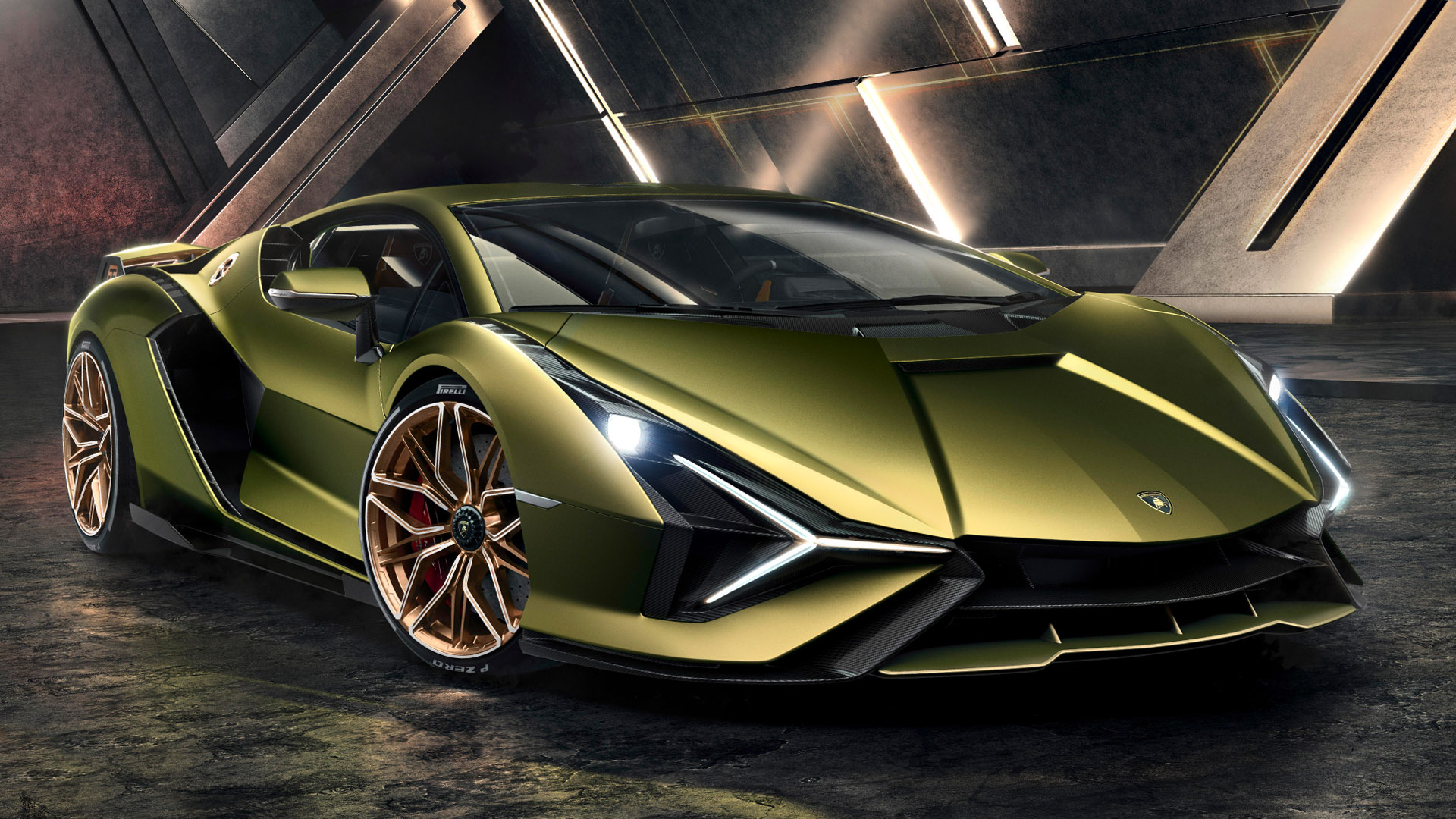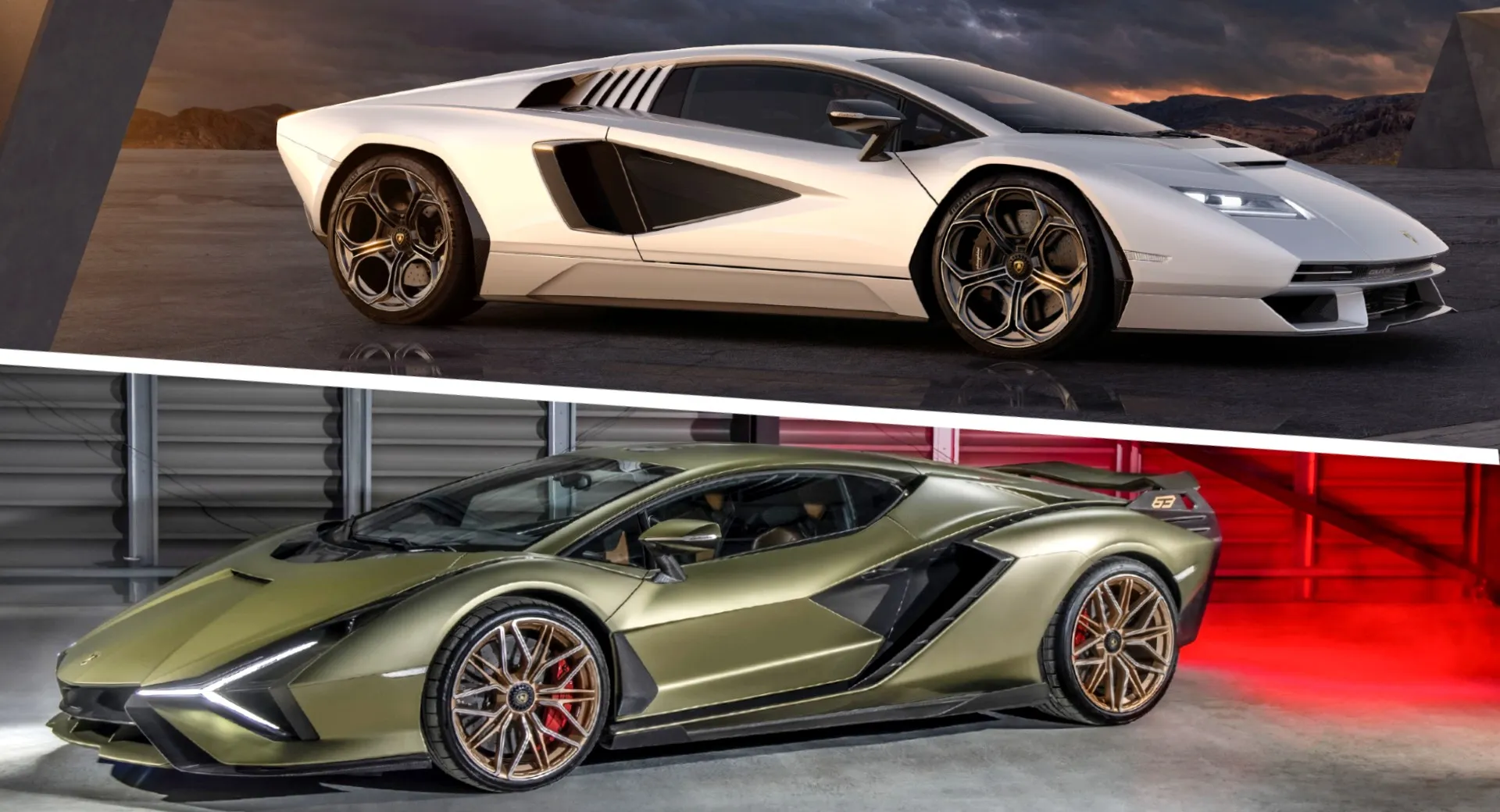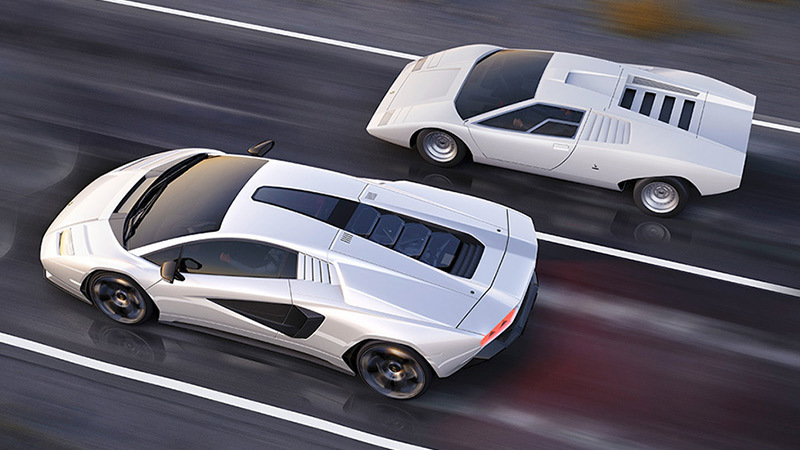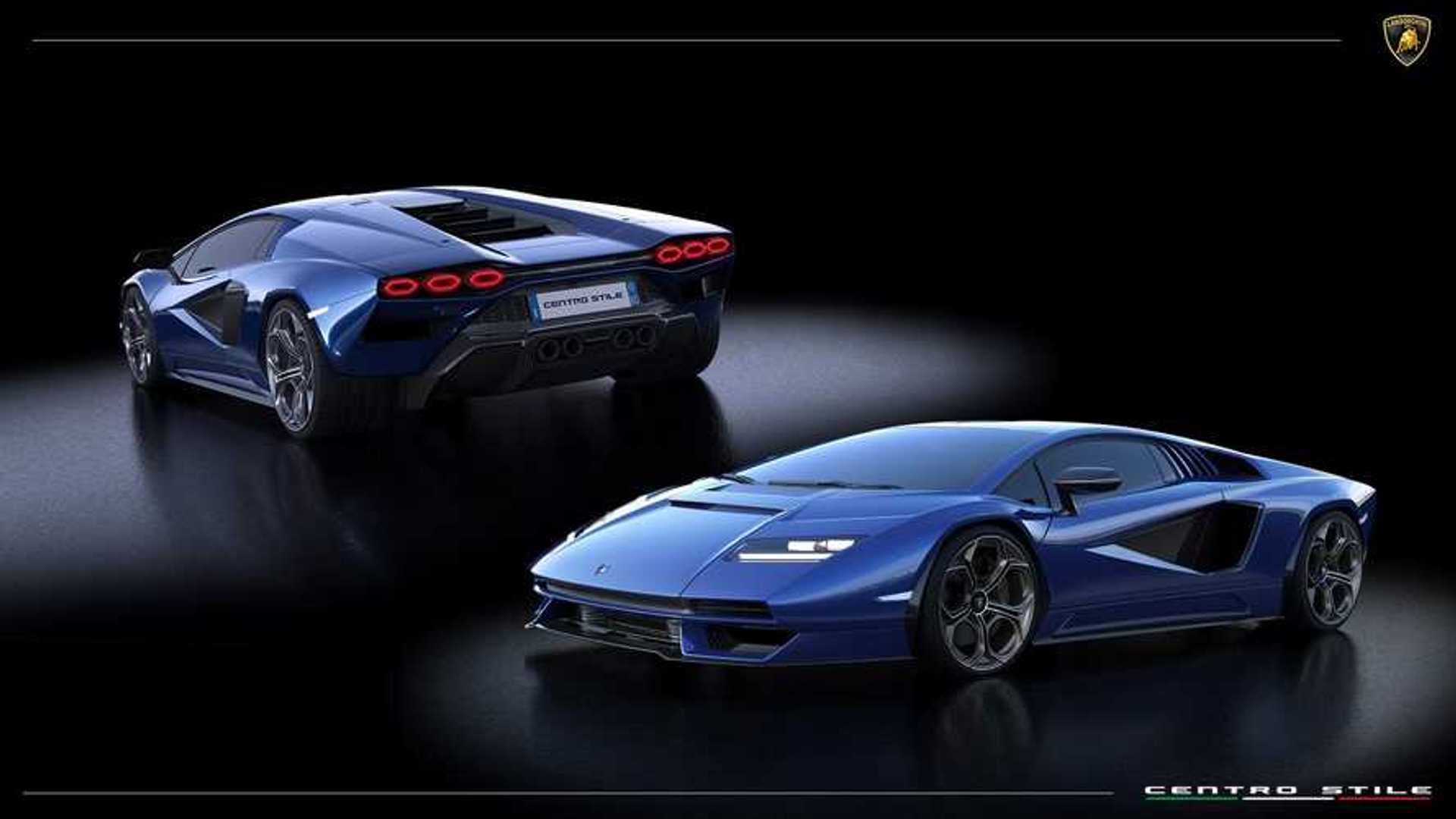¿Cómo se compara el Lamborghini Countach LPI 800-4 con el Sián FKP 37?
14 DE AGOSTO DE 2021
El Countach LPI 800-4 recientemente presentado comparte sus fundamentos con el
Sián FKP 37, incluido el monocasco de fibra de carbono, el V12 híbrido suave (en una forma un poco menos potente) y el supercondensador. Sin embargo, a pesar de presentar una carrocería completamente rediseñada hecha de fibra de carbono, la versión moderna del legendario
Countach tiene algunas similitudes más con el
Sián que no pueden pasar desapercibidas. Es por eso que decidimos hacer una comparación visual de lado a lado y examinar cuidadosamente el diseño de los dos especiales de edición limitada de Sant'Agata.
Comenzando por la parte delantera, la diferencia en el enfoque de diseño es evidente desde el primer vistazo. El
Countach tiene una nariz más plana con líneas simples y tomas rectangulares que no tiene nada que ver con los elementos ultra agresivos del Sián. La única característica de diseño común es el ángulo negativo de las líneas hacia la entrada del capó (en realidad son las líneas cerradas en el Countach), que es un elemento de diseño que se encuentra, en diferentes variaciones, en casi todos los modelos de Lamborghini desde el Countach LP400 de 1974.
Lo que definitivamente es común en ambos autos es el parabrisas delantero derivado del Aventador, los pilares A y la estructura del techo, al menos hasta el pilar B. Esto es más evidente desde una vista de 3/4 o lateral, donde también se pueden ver las ventanas laterales y las tapas de los espejos idénticos.


Como era de esperar, desde el perfil, las proporciones se ven bastante similares. Al final del día, esto es algo que los diseñadores no pueden alterar fácilmente cuando trabajaban con el mismo monocasco, diseño de motor, invernadero, distancia entre ejes, tamaño de rueda (20 pulgadas en la parte delantera y 21 pulgadas en la parte trasera). y pistas, especialmente teniendo en cuenta que necesitaban mantener la característica silueta de cuña.
Además de las ventanas laterales y la línea del techo que se parecen a las del
Aventador , el Countach tiene algunas características de inspiración retro que no se comparten con el Sián. Estos incluyen los pasos de rueda hexagonales delanteros y traseros, las llantas únicas y las diferentes formas de las tomas laterales. Si se pregunta por qué el conducto de aire de estilo NACA es mucho más grande en comparación con el
Countach original , solo mire las tomas laterales del Sián y el Aventador para tener una idea de cuánto enfriamiento se necesita para el V12 moderno. El Sián también tiene estribos laterales más agresivos que combinan con su divisor delantero.


Y ahora pasamos a la parte trasera, que es el ángulo de aspecto más similar para los dos modelos. Para empezar, ambos comparten las mismas luces traseras LED hexagonales de tres unidades. Esta es una decisión extraña considerando la naturaleza exclusiva del resurgimiento de
Countach que podría justificar el costo de desarrollo de unidades de iluminación únicas.
Otra característica de diseño que parece bastante similar en ambos casos es el diseño de "periscopio" del techo, aunque la cubierta del motor y el área circundante se rediseñaron en el Countach. El Sián también tiene las exclusivas aletas laterales que complementan el alerón trasero activo. Aunque este último es probablemente una pieza única dado el tratamiento de la superficie de la cola, es probable que el Countach tenga un ala activa similar que contribuye a un diseño limpio.
Debajo de los faros, cada automóvil tiene su propio diseño de parachoques, y el Countach adopta un enfoque más sensato para las tomas y el difusor, que se integra mejor en el diseño. Lo mismo puede decirse de los cuatro tubos de escape redondos del Countach en lugar de los tubos dobles hexagonales del Sián. Habiendo dicho eso, ambos superdeportivos reciben un tratamiento de atajo similar para el parachoques que revela una gran parte de los neumáticos traseros anchos.




En el interior, ambos autos tienen muchos componentes derivados del
Aventador , como el volante y el grupo de instrumentos digitales, pero cuentan con una consola central y un túnel únicos con una pantalla táctil de infoentretenimiento más grande de 8.4 pulgadas y un diseño más moderno para los controles.
Las diferencias entre el Countach y la cabina Sian se limitan al diseño del asiento (el primero comparte los asientos con el Aventador), las exclusivas salidas de aire para el clima y la forma del tapizado de cuero en el túnel central, las puertas y el revestimiento del techo. El Countach también tiene el botón "Stile" que inicia una presentación de la filosofía de diseño del automóvil.


Y después de cubrir el diseño tanto del exterior como del interior, echemos un vistazo rápido al tren motriz compartido. Consiste en un V12 atmosférico de 6.5 litros, un motor eléctrico de 48 voltios, una caja de cambios automática y un supercondensador, pero hay una ligera diferencia en términos de potencia combinada.
Más específicamente, el Countach LPI 800-4 produce un combinado de 803 hp (599 kW / 814 PS) mientras que el Sián tiene 808 hp (603 kW / 819 PS). Esta pequeña diferencia a favor del Sián tiene que ver con la calibración del motor V12 de aspiración natural y no con el idéntico motor eléctrico de 34 CV (25 kW / 34 CV). En el Countach, el motor ICE produce 769 hp (574 kW / 780 PS) frente a los 774 HP del Sián (577 kW / 785 PS). A pesar de eso, el rendimiento es idéntico, con una aceleración de 0-100 km / h (0-62 mph) en 2.8 segundos y de 0-200 km / h (0-124 mph) en 8.6 segundos. La velocidad máxima es de 355 km / h (221 mph) para el Countach y más de 350 km / h (217 mph) para el
Sián.
Lea también: Charging Bull: Lamborghini Boss describe la estrategia de electrificación, prepara la cuarta línea de modelos de vehículos eléctricos para 2025+


Así que este es nuestro vistazo a dos Lamborghinis basados en Aventador muy especiales. Ambos se producen en cantidades limitadas, siendo el Sián FKP 37 más exclusivo, con 63 unidades del
Coupé y 19 unidades del
Roadster frente a las 112 unidades del Countach LPI 800-4, que solo está disponible como cupé.
No tenemos precios para el Countach LPI 800-4, pero esperamos que cueste menos que el Sián FKP 37, que comienza en $ 3,700,000. Si pudiera pagarlos, ¿cuál de los dos toros electrificados le gustaría tener en su garaje?
How Does The Lamborghini Countach LPI 800-4 Compare To The Sián FKP 37?
AUGUST 14, 2021
The recently unveiled Countach LPI 800-4 is sharing its underpinnings with the
Sián FKP 37 including the carbon-fiber monocoque, the mild-hybrid V12 (in a slightly less powerful guise), and the supercapacitor. However, despite featuring a completely redesigned bodywork made of carbon fiber, the modern version of the legendary
Countach has a few more similarities with the
Sián that can’t be unseen. This is why we decided to make a side-to-side visual comparison and carefully examine the design of the two limited edition specials from Sant’Agata.
Starting with the front end, the difference in the design approach is evident from the first glimpse. The
Countach has a flatter nose with simple lines and rectangular intakes which has nothing in common with the ultra-aggressive elements on the Sián. The only common design feature is the negative angle of the lines towards the bonnet intake (they are actually the shut lines on the Countach), which is a design element found, in different variations, in almost every Lamborghini model since the 1974 Countach LP400.
What is definitely common in both cars is the Aventador-derived front windshield, the A-pillars, and roof structure – at least up to the B-pillar. This is more evident from a 3/4 or a side view where you can also see the identical side windows and mirror caps.
As expected, from the profile, the proportions look quite similar. At the end of the day, this is something that designers can’t easily alter when they were working around the same monocoque, engine layout, greenhouse, wheelbase, wheelsize (20-inches at the front and 21-inches at the rear), and tracks – especially considering they needed to maintain the characteristic wedge silhouette.
Besides the side windows and roofline looking similar to the
Aventador‘s, the Countach has some retro-inspired features that are not shared with the Sián. These include the hexagonal wheel-arches front and rear, the unique rims, and the different shapes of the side intakes. If you are wondering why the NACA-style air-duct is so much larger compared to the
original Countach, just look at the side intakes of the Sián and the Aventador to get an idea of how much cooling is needed for the modern V12. The Sián also gets more aggressive side sills matching its front splitter.
And now we move to the rear end which is the most similar-looking angle for the two models. For a start, both of them share the same hexagonal three-unit LED taillights. This is a weird decision considering the exclusive nature of the
Countach revival that could justify the development cost for unique lighting units.
Another design feature that looks quite similar in both cases is the “periscope” design of the roof, although the engine cover and the surrounding area are redesigned in the Countach. The Sián also has the signature side fins complimenting the active rear spoiler. Although the latter is probably a unique part given the surface treatment of the tail, it is likely that the Countach has a similar active wing which contributes to a clean design.
Below the headlights, each car gets its own bumper design, with the Countach adopting a more sensible approach for the intakes and the diffuser which is integrated more nicely in the design. The same can be said about the four round tailpipes of the Countach instead of the hexagonal dual pipes of the Sián. Having said that, both supercars get similar short-cut treatment for the bumper revealing a large portion of the wide rear tires.
Inside, both cars have many
Aventador-derived components like the steering wheel and the digital instrument cluster, but they feature a unique center console and tunnel with a larger 8.4-inch infotainment touchscreen and a more modern design for the controls.
Differences between the Countach and the Sian cabin are limited to the seat design (the former shares the seats with the Aventador), the unique climate vents, and the shape of the leather trim on the central tunnel, doors, and roofliner. The Countach also has the “Stile” button that initiates a presentation of the car’s design philosophy.
And after we covered the design of both the exterior and the interior, let’s take a quick look into the shared powertrain. It consists of a 6.5-liter naturally aspirated V12, a 48-Volt e-motor, an automatic gearbox and a supercapacitor, but there’s a slight difference in terms of combined output.
More specifically, the Countach LPI 800-4 produces a combined 803 hp (599 kW / 814 PS) while the Sián has 808 hp (603 kW / 819 PS). This small difference in favor of the Sián has to do with the calibration of the naturally aspirated V12 engine and not with the identical 34 hp (25 kW / 34 PS) electric motor. In the Countach, the ICE motor produces 769 hp (574 kW / 780 PS) versus the Sián’s 774 HP (577 kW / 785 PS). Despite that, performance is identical, with 0-100 km/h (0-62 mph) acceleration in 2.8 seconds and 0-200 km/h (0-124 mph) in 8.6 seconds. The top speed is 355 km/h (221 mph) for the Countach and over 350 km/h (217 mph) for the
Sián.
So this is our look at two very special Aventador-based Lamborghinis. Both are produced in limited numbers, with the Sián FKP 37 being more exclusive, with 63 units of the
Coupe and 19 units of the
Roadster versus the 112 units for the Countach LPI 800-4, which is only available as a coupe.
We don’t have pricing for the Countach LPI 800-4 but we expect it to cost less than the Sián FKP 37 which starts from $3,700,000. If you could afford them, which one of the two electrified bulls would you like to have in your garage?



















































 Ya sabes que el alirón que le calzaron al Countach era de palo, vamos que no era funcional, incluso tenía otro delantero opcional... eran otros tiempos
Ya sabes que el alirón que le calzaron al Countach era de palo, vamos que no era funcional, incluso tenía otro delantero opcional... eran otros tiempos 






